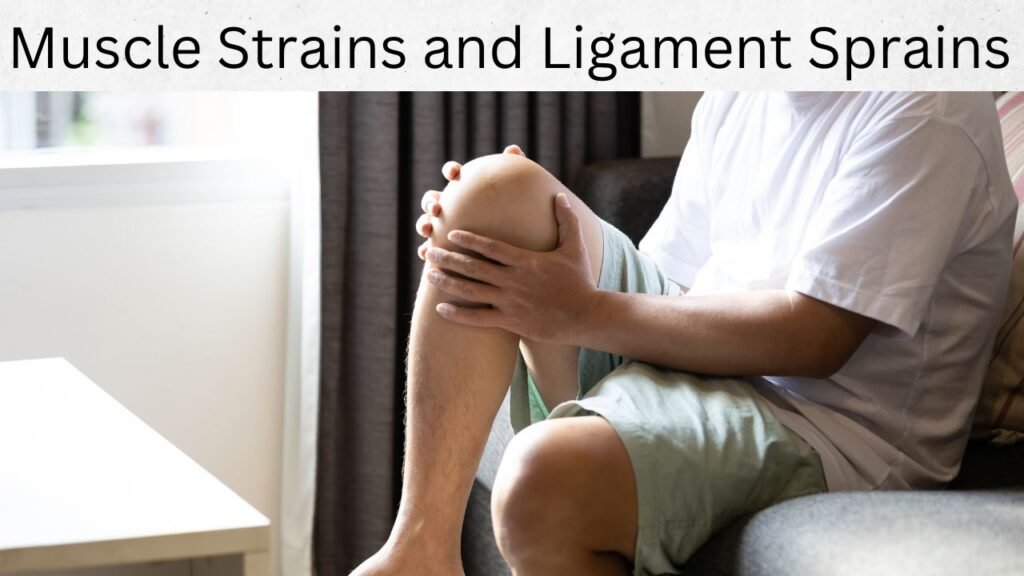Muscle strains and ligament sprains are among the most common injuries, affecting athletes, active individuals, and even those with sedentary lifestyles. While they may seem similar, they impact different parts of the body and require distinct treatment approaches. Understanding their causes, symptoms, and recovery strategies can help prevent further injury and promote faster healing.

Understanding the Difference: Muscle Strains vs. Ligament Sprains
A muscle strain occurs when muscle fibers are overstretched or torn due to excessive force, sudden movements, or repetitive stress. Strains commonly affect the lower back, hamstrings, and shoulders.
A ligament sprain happens when ligaments, the tough bands of tissue connecting bones, are stretched or torn. This type of injury typically affects joints such as the ankles, knees, and wrists.
While both injuries involve overstretching, strains affect muscles or tendons, while sprains involve ligaments.
Common Causes of Muscle Strains and Ligament Sprains
Several factors contribute to these injuries, including:
- Sudden Movements: Quick, forceful movements, such as sprinting or jumping, can cause excessive strain on muscles and ligaments.
- Overuse and Repetitive Motion: Repetitive activities, such as lifting weights, running, or prolonged standing, can weaken tissues over time.
- Poor Warm-Up Routine: Skipping warm-ups before exercise reduces flexibility and increases the risk of injury.
- Weak or Tight Muscles: Insufficient muscle strength and flexibility can make muscles and ligaments more vulnerable to strain or sprain.
- Improper Technique: Incorrect form while exercising or lifting heavy objects can put excessive stress on muscles and ligaments.
- Falls and Accidents: Sudden impact, missteps, or uneven surfaces can lead to ligament sprains, especially in the ankles and knees.
Recognizing the Symptoms
The symptoms of muscle strains and ligament sprains vary depending on the severity of the injury but generally include:
Muscle Strain Symptoms:
- Pain and tenderness in the affected muscle
- Swelling and bruising
- Muscle weakness or difficulty moving the injured area
- Muscle spasms or cramping
Ligament Sprain Symptoms:
- Sudden pain in the affected joint
- Swelling and inflammation
- Joint instability or limited range of motion
- Bruising around the injured area
Treatment and Recovery Strategies
Proper treatment is essential for a full recovery and to prevent long-term complications. Most mild to moderate strains and sprains can be treated with self-care, while severe cases may require medical intervention.
Immediate Care: The R.I.C.E. Method
For both muscle strains and ligament sprains, the R.I.C.E. (Rest, Ice, Compression, Elevation) method is the first line of treatment:
- Rest: Avoid activities that put stress on the injured area to prevent further damage.
- Ice: Apply an ice pack wrapped in a cloth for 15-20 minutes every few hours to reduce swelling and numb pain.
- Compression: Use a compression bandage to stabilize the injury and control swelling.
- Elevation: Keep the injured area elevated above heart level to minimize swelling.
Pain Management
- Over-the-counter pain relievers such as ibuprofen or acetaminophen can help reduce pain and inflammation.
- Gentle stretching and massage therapy may aid in muscle relaxation and pain relief.
Rehabilitation and Strengthening Exercises
Once the pain subsides, rehabilitation exercises are crucial for restoring strength and flexibility:
- Stretching exercises improve mobility and prevent stiffness.
- Strength training helps rebuild muscle function and stability.
- Balance exercises are particularly important for preventing recurrent ligament sprains, especially in the ankles and knees.
When to See a Doctor
While mild strains and sprains heal on their own, medical attention is necessary if you experience:
- Severe pain that doesn’t improve with rest
- Inability to bear weight on the affected limb
- Extreme swelling, bruising, or visible deformity
- Persistent instability in the affected joint
A healthcare provider may recommend imaging tests such as X-rays or MRIs to assess the severity of the injury. In severe cases, physical therapy or even surgery may be required.
Preventing Future Injuries
Prevention is key to avoiding recurrent muscle and ligament injuries. Consider these strategies:
- Warm Up and Cool Down: Properly warming up before activity and cooling down afterward improves flexibility and reduces injury risk.
- Strength Training: Strengthening muscles and joints provides better support and prevents overuse injuries.
- Use Proper Form and Technique: Ensuring correct posture and body mechanics during exercises or lifting can protect muscles and ligaments.
- Wear Supportive Footwear: Proper shoes provide stability and reduce the risk of falls and missteps.
- Listen to Your Body: Avoid overtraining and take breaks when experiencing fatigue or discomfort.
Conclusion
Muscle strains and ligament sprains are common but preventable injuries. Understanding their causes, recognizing symptoms early, and following effective treatment strategies can lead to faster recovery. Prioritizing warm-ups, strengthening exercises, and proper technique can significantly reduce the likelihood of future injuries. If symptoms persist or worsen, seeking medical attention is essential to prevent long-term complications and ensure a full recovery.